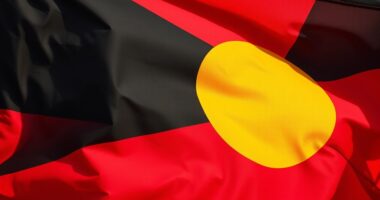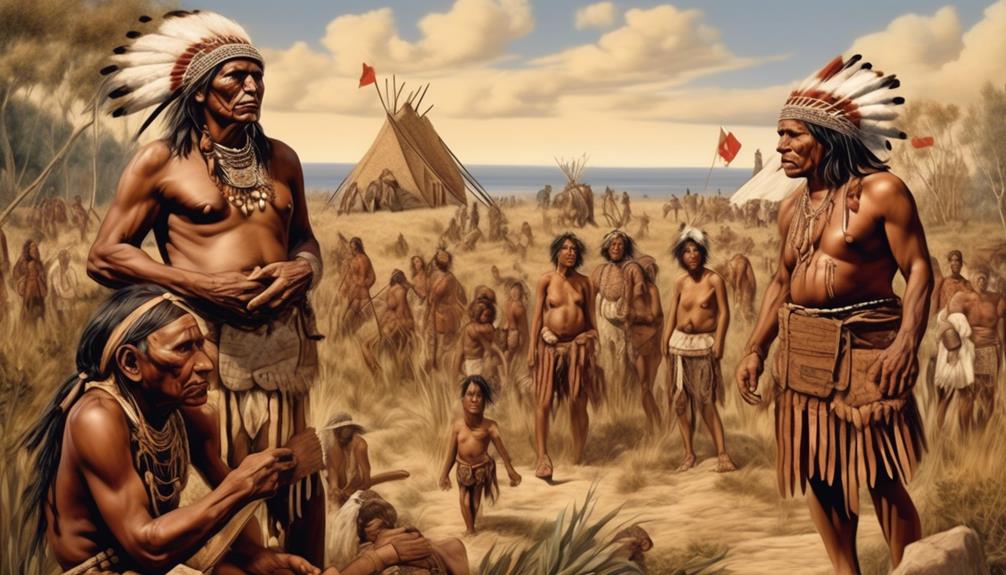Message sticks are a unique communication tool used by Indigenous Australians, acting as their original postal service. If you explore their designs, you’ll notice symbols, patterns, and motifs that carry specific messages, often crafted by elders with traditional techniques. Made from durable woods and decorated with natural pigments, these sticks connect communities across vast distances, embodying stories, cultural identity, and spiritual beliefs. Keep going to discover how these remarkable objects continue to preserve Indigenous heritage today.
Key Takeaways
- Message sticks serve as traditional communication tools connecting Indigenous Australian communities across vast distances.
- They feature symbolic designs, patterns, and motifs that convey specific messages and cultural meanings.
- Crafted using durable woods and decorated with natural pigments, reflecting skilled techniques passed down through generations.
- The sticks function as tangible, portable links embodying stories, traditions, and spiritual beliefs.
- Acting as a sophisticated, culturally respectful “postal” system, they facilitate urgent messages, invitations, and important news.

Message sticks have long served as a vital communication tool for Indigenous Australians, acting as a direct link between communities across vast distances. These sticks are more than simple objects; they are powerful symbols embedded with cultural significance. When you hold a message stick, you’re holding a piece of history that connects people, stories, and traditions. The designs and markings on each stick are carefully crafted, often reflecting the message’s purpose, the sender, and the cultural context. These symbols can include intricate patterns, animal motifs, or abstract signs, each carrying specific meanings understood by the community. This layered symbolism ensures that the message conveyed is clear, respectful, and culturally appropriate.
Making techniques for message sticks are passed down through generations, emphasizing craftsmanship and cultural knowledge. You might notice that the making process involves selecting particular types of wood, such as witchetty or boab, which are chosen for their durability and cultural resonance. The sticks are often carved, painted, or decorated using natural pigments derived from ochre, charcoal, or plant dyes. These materials are carefully applied with simple tools, and every step reflects a deep respect for tradition and environment. The craftsmanship isn’t just about creating a functional object; it’s an act of cultural expression, preserving stories and identities through art. When making a message stick, you become a custodian of your community’s history and a participant in a living tradition. The making techniques are deliberate, emphasizing precision and symbolism, as each mark or pattern is meaningful. Additionally, cultural transmission plays a vital role in maintaining the integrity and continuity of these practices across generations.
The physical act of creating a message stick also strengthens cultural bonds. It’s a communal activity where elders pass on knowledge to younger generations, teaching them about the significance of symbols, the importance of storytelling, and the respectful way to communicate. The finished message stick serves as a portable message, easily transported to deliver urgent news, ceremonial invitations, or important instructions. It acts as a visual, tangible link that transcends language barriers, conveying complex messages through shared understanding of symbols and cultural codes.
In essence, message sticks are a unique blend of art, communication, and cultural identity. You recognize their value not just as communication tools but as revered cultural artifacts that embody the history, stories, and spiritual beliefs of Indigenous Australians. Their making techniques and symbolism highlight a sophisticated system of communication that predates modern postal services, showing how Indigenous Australians have long mastered the art of message delivery through meaningful, durable, and culturally significant objects.
Frequently Asked Questions
How Were Message Sticks Decorated or Personalized?
You might wonder how message sticks were decorated or personalized. You’d see Indigenous symbolism and artistic patterns carefully carved or painted onto the sticks, each representing specific messages, stories, or cultural significance. These decorations weren’t random; they conveyed meaning and identity. By incorporating unique symbols and intricate designs, the message sticks became personalized, ensuring the message was understood by the recipient, while also honoring cultural traditions and storytelling through art.
What Materials Were Traditionally Used to Make Message Sticks?
You might think message sticks are simple, but they’re crafted with care using traditional materials like hardwoods, which guarantee material durability. Sometimes, they feature intricate traditional designs that contrast with their sturdy construction. These sticks often include natural pigments or carvings, blending artistry with function. Their creation reflects a deep understanding of material properties, ensuring the message endures while honoring cultural significance through craftsmanship.
How Did Message Sticks Facilitate Cultural Exchange?
You see, message sticks facilitated cultural exchange by serving as tools for Indigenous storytelling and communication. When you carry these sticks, you’re connecting with other groups, sharing messages, and passing down traditions. They help build cross-cultural connections, allowing different communities to exchange knowledge, warn of dangers, or arrange meetings. Through this, message sticks foster understanding and preserve cultural heritage, strengthening bonds across diverse Indigenous groups.
Were Message Sticks Used Exclusively for Communication or Also Ceremonial?
You might think message sticks were only for communication, but they also held ceremonial meaning. Indigenous storytelling and ritual symbolism played a big role, as these sticks conveyed stories and cultural lessons during ceremonies. When used this way, they became sacred objects that reinforced traditions and social bonds. So, message sticks served both practical communication and ceremonial purposes, blending storytelling with ritual symbolism to honor and preserve Indigenous culture.
How Did Message Sticks Evolve With European Colonization?
Imagine a river of history flowing, carrying messages across vast lands. With European colonization, message sticks transformed from sacred storytellers into tools of colonization, disrupting indigenous storytelling and trade networks. They were often repurposed to communicate with settlers, losing their ceremonial significance. This evolution reflects how colonization reshaped communication, intertwining and often erasing indigenous traditions, yet their legacy still whispers through the remaining message sticks and stories.
Conclusion
So, next time you send a message, remember the message stick’s story—an enduring symbol of connection and trust. Just like those ancient carriers, your words carry power, bridging gaps and forging bonds. Think of your message as a tiny torch, lighting up someone’s day across distances. In this way, the art of message sticks reminds us that even in a busy world, a simple act of communication can be a powerful spark—igniting understanding and friendship.









